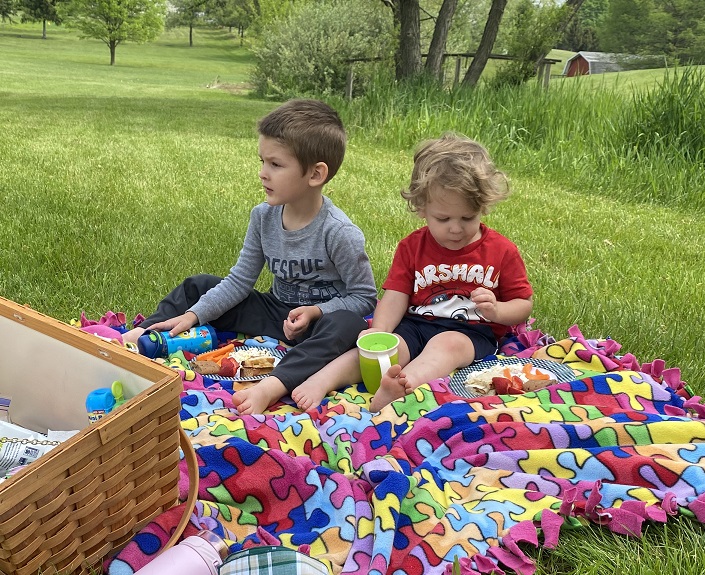
by IABA Team | Jul 6, 2021
Children with autism who work with Board Certified Behavior Analysts in a therapeutic ABA setting learn skills that help them function independently. These kids never work in a vacuum, since the long-term goal is the effective transfer of these skills from the ABA therapy center to their wider world.
In fact, ABA therapy can be more satisfying and effective when the whole family gets involved.
What Does Family Support for Autism Look Like?
Family support can include a wide range of elements, and each family needs something unique.
Potty training is a great example. Often, children find success in clinical settings but not as much in their home environment. Clinicians can work with parents to develop a plan that extends into a child’s home and school life.
With a goal to promote independence across all environments, therapists work with families to increase effective communication between parents, siblings, and the child with autism.
Oftentimes children won’t have developed language skills and ABA therapists come up with a communication system that parents can use. Whether it’s verbal, limited sign language, or picture exchanges, these methods can be used at home.
Parent-Therapist Communication
Maintaining therapeutic practices at home and not just in clinical settings is crucial for ABA therapy to have a life-changing impact.
Family involvement can start with the simple process of sharing with parents what the child is working on in the ABA therapy setting. As new families get familiar with the basics of ABA therapy, it really helps them understand what they can do at home, like how to respond to tantrums.
In some cases, just having help in creating a morning or nighttime routine can make all the difference to everyone in the family. Ideally, parents and families make time to meet or talk with therapists on a weekly basis, though many parents have busy schedules.
ABA Therapy from IABA Consultants
If you have questions regarding autism treatment with ABA therapy, we are here for you! Our goal is to make sure no family is turned away due to financial constraints. Our therapy team would love to talk to you. Find the location closest to you and give us a call. We’re here for you.
Sources: Chicago Parent Magazine

by IABA Team | Jun 29, 2021
Applied behavior analysis (ABA) therapy is administered by professionals. As a parent, you play an important role in choosing the right person to help your child. But your work won’t stop when the professional begins.
Effective ABA therapy for people with autism spectrum disorders (ASD) relies on active parent participation. You help your child to learn around the clock, even when the technician isn’t present.
You’ll have plenty of training to help you get started. You won’t be in this alone. But following a few basic do’s and don’ts can ensure your child gets the most out of therapy.
Finding the Right ABA Professional
Before you can play a role in your child’s ABA therapy, you’ll need someone to guide the process. That person is a therapist, and as a parent, you have the power to choose the right person.
Therapists certified by the Behavior Analyst Certification Board will have the letters BCBA after their names. Someone like this is qualified to create and oversee the treatment plan for your child.
Registered behavior technicians (RBTs) carry out the treatment plan that is created by a BCBA therapist. RBTs should be supervised by a BCBA through regular meetings, written reports, or both.
Parent Participation in ABA Therapy Is Critical
Researchers say that treatment works best when parents stay engaged. You know your child better than anyone else does, and you spend the most time with them. You’re in the perfect position to help tailor treatment and encourage skill-building.
You’re not expected to know everything about ABA therapy when treatment begins. Your child’s therapist is your guide. This is why it’s important to find a therapist you can trust. You will learn all about therapy goals and how you can help.
Ask your therapist for help with anything that seems unclear. They are there to guide you through the process.
ABA Therapy Best Practices
Follow best practices to ensure that your child has the best ABA therapy experience possible.
Throughout your child’s ABA therapy journey, you should:
- Help yourself. Juggling work, childcare, education, and ABA therapy isn’t easy. Reach out to ASD support groups, experts suggest. In these groups, you can connect with others who are also dealing with these responsibilities. You may pick up tools and tricks that help you cope.
- Practice everywhere. The more frequently your child can practice in novel situations, the better, experts say. Use shopping trips, car rides, doctors’ appointments, and church services as opportunities to solidify ABA therapy lessons.
- Ask for progress reports. A child in ABA therapy should learn new skills and behaviors. You should see these in action as you move through each day with your child. You’ll see improvements in virtually every area of life, including academics, socialization, and day-to-day functioning. But your child’s therapist should also craft reports you can read and understand. Tracking data helps professionals to determine the next steps in the treatment plan.
- Listen to your child. ABA therapy can be fun, enticing, and even a bit exciting. If your child seems nervous, scared, or angry, pay attention. You may need a different technician or a modification to the approach. It doesn’t necessarily mean that ABA therapy isn’t a good fit for your child. The approach might just need to be altered somewhat. Talk to your child’s technician about any issues that arise.
- Ask for feedback. You’re part of the treatment team, and you are working hard. Ask your technician for advice about your role. Are you handling the work properly? Where can you improve?
Many parents enjoy ABA therapy. They look forward to the appointments, and they feel pride as their children learn and grow.
While parents are often involved in therapy sessions, they also have the opportunity to relax a bit as technicians take the wheel in these sessions. Parenting a child with autism is a full-time job. Getting hands-on guidance from a professional on a consistent basis can be invaluable.
You will have ups and downs in progress. That’s expected. But follow these steps, and you might like the therapy as much as your child does.
What to Avoid During ABA Therapy
Parents of children with ASD have plenty of tasks to tackle, and everyone makes mistakes now and again. You won’t be the perfect parent or caretaker. No one is. But avoiding some common mistakes as much as you can help your child.
As ABA therapy progresses, avoid:
- Skipping appointments. Your calendar is packed tight, and it’s tempting to let one or two visits slide. Avoid that temptation. Your child needs many meetings with professionals to get better and make progress. When appointments are skipped, your child may lose the progress they have made thus far. This means a longer treatment timeline and slower results. Don’t let therapy take a backseat to other obligations.
- Certain punishments. It’s easy to think that negative reinforcement is the best way to stop undesirable behavior, but it’s been shown to have the opposite effect. ABA therapy uses rewards for positive steps, and certain responses are used to discourage negative behavior. Behavioral technicians do not use physical punishment when kids don’t comply. This is a common misunderstanding among therapists and parents, experts say. If you’re not sure how to handle negative behavior, ask your therapist. Therapy should be fun, so kids will participate without coercion.
- Backsliding. Consistency makes for effective ABA therapy. Kids should know what will happen and when. It’s tempting to let your child bend the rules now and then just to avoid a discussion. But doing so makes the lesson harder to grasp. Stick with the plan your therapist outlined.
- Accelerating. ABA therapy is built on a series of very small steps that a child masters one by one. You can see the goal in sight, but your child might not see it yet. Don’t push your child to do anything they don’t understand quite yet. Be patient and let the therapy work. It takes time, but the gains are well worth it.
- As with most things, there is a learning curve with ABA therapy. With more sessions, you’ll feel more confident in the approach, and you’ll be better able to reinforce the lessons learned in sessions.
Everyone makes mistakes. If you slip, don’t berate yourself. But look for ways to start fresh tomorrow, so you can help your child as much as possible.
ABA Therapy from IABA Consultants
If you have questions regarding autism treatment with ABA therapy, we are here for you! Our goal is to make sure no family is turned away due to financial constraints. Our therapy team would love to talk to you. Find the location closest to you and give us a call. We’re here for you.
Sources
Sprout Therapy ABA Information

by IABA Team | Jun 10, 2021
Deciding to objectively look at your child for signs of autism is hard. Thinking about your child possibly needing alternate care or schooling when that child is still a baby was not what you signed up for. But detecting early signs of Autism Spectrum Disorder (ASD) and seeking a professional diagnosis is the best way to make sure your child lives a productive and happy life.
Early signs of ASD are not easy to detect and you should always seek a professional opinion with your observations and concerns. It is not possible to diagnose your own child with ASD from reading online tests, blogs, or watching videos. The purpose of this blog is what to look for that could potentially be a valid concern for your child.
Many early signs of ASD can be confused with normal developmental behavior. All children develop at different rates. There are some behaviors that may be valid reasons for raising concern. Let’s take a look at what to look for (and what not to look for) when it comes to your infant or young child and ASD.
What are the Warning Signs of ASD in Young Children and Infants?
There are several marker behaviors that parents should take into account when observing their infant or young child developing. Again, note that none of these behaviors means your child has ASD. These are simply behaviors that are commonly associated with ASD if they persist.
The behaviors listed are from the CDC and Autism Awareness Center.
Infant Behavior Markers (up to 12 months)
- Does not make or maintain eye contact
- Lack of facial expressions (never smiles or frowns)
- Does not respond to their name by 9 months
- Uses few or no gestures
- Does not respond to verbal cues or ‘games’
- Lack of attempts at verbal communication
Young Child Behavior Markers (up to 24 months)
- Does not share interests, such as found objects or toys by 15 months
- No pointing to indicate things by 18 months
- Lack of empathy (recognizing others are happy or sad) by 24 months
- Delayed language, motor, or cognitive skills
- Interested primarily in objects and not people
- Gets upset by minor changes
- Has unusual or extreme reactions to sensory experiences (touch, taste, smell)
Other Potential Early ASD Markers
The CDC lists the following as other marker behaviors commonly exhibited by those with ASD:
- Preterm births or low birth weight
- Environmental exposure to hazards like lead paint
- Hyperactive, impulsive, and/or inattentive behavior
- Epilepsy or seizure disorder
- Unusual eating and sleeping habits
- Gastrointestinal issues (e.g., constipation)
- Unusual mood or emotional reactions
- Anxiety, stress, or excessive worry
- Lack of fear or more fear than expected
Remember, all of the above behaviors and characteristics are just general markers. Some children who get diagnosed with ASD won’t exhibit any of the signs listed above. Always speak to a medical professional when you are unsure of what to be concerned about.
When do the Signs of ASD Start to Show?
Autism Spectrum Disorder is hard to diagnose, as there are no medical tests that reveal it. Diagnoses are made from testing conducted by medical professionals based on behaviors, developmental milestones, and other specific criteria.
With that said, warning signs of ASD can begin to manifest as early as 9 months of age. These are warning signs, not a diagnosis, however, and need to be monitored. Keeping an eye on specific behaviors and conferring with a professional is the first step if you notice one or more marker behaviors that don’t go away as the child gets older.
The CDC notes that “ASD can sometimes be detected by 18 months or younger,” but that 24 months is the age where “a diagnosis by an experienced professional can be considered very reliable.”
When Should I Seek a Professional Opinion?
The best way to seek a professional opinion is by getting one directly from your child’s pediatrician. Pediatricians can help with screening and recommendations. Sometimes developmental disorders and signs of ASD are part of a regular wellness visit for your child. Talk to your pediatrician about specifics if you have questions or concerns.
ASD screening is recommended by many pediatricians at specific developmental intervals. If your child’s pediatrician doesn’t mention an ASD screening at a wellness visit and you have concerns, ask them about it.
The American Academy of Pediatrics (AAP) recommends developmental screening for all children at doctor wellness visits at 9 months, 18 months, and 36 months of age. The AAP also strongly recommends screening specifically for signs of ASD at 18 months and 24 months.
If your child’s pediatrician believes that your child is at risk for ASD, there are two paths you can take for a formal diagnosis and care plan: private evaluations & interventions and state-sponsored early intervention programs.
What is a Private Evaluation?
Private simply refers to private pay i.e. paid for out-of-pocket or covered by an insurance company. These evaluations allow parents to select a care program of their choice to help evaluate their child.
Private evaluations are in-depth looks at a child’s development. These evaluations are handled by a licensed medical professional like a child psychologist, speech-language pathologist, occupational therapist, developmental pediatrician, or another specialized professional
These evaluations screen your child, analyze the data, determine whether or not the child needs specialized care, and then help develop a course of action. Keep in mind that private-pay evaluations may not be covered by your insurance and can cost lots of money out-of-pocket.
If you don’t have insurance or can’t afford out-of-pocket expenses for a private ASD screening/evaluation, you should look at your state’s Early Intervention program.
What is an ASD Early Intervention?
For those who cannot take on the financial burden or private ASD testing and screening, Early Intervention (EI) programs are available from individual states. These programs help families with children under 3 years of age get screened and will create a care plan if necessary. States are required by the federal government to provide several services free of charge.
If a screening or concern from your child’s pediatrician notes several at-risk behaviors, you may be encouraged to start an EI. Early intervention screenings do not require a formal diagnosis and are conducted by federal EI specialists.
The EI specialists will determine whether or not your child requires more comprehensive care. EI specialists will recommend the type of care they believe will be the most beneficial for your child.
What Should I Do If My Young Child is Diagnosed with ASD?
Both of the paths to getting a legitimate ADS screening or evaluation listed above will provide you with a care plan. Following this care plan will get you started on helping your child get the services they need to flourish.
After an ASD diagnosis, children are commonly referred to work with one of the following types of professionals:
- Psychologists
- Behavioral Analysts
- Developmental Therapists
- Social Workers
- Speech Therapists
- Occupational Therapists
- Physical Therapists
This is not a comprehensive list, it is simply to give you an idea of where your child may start in their developmental journey.
On top of your child receiving special care you, as a parent, will need to learn how to best help your child grow and develop. Talk to your child’s healthcare professional to learn what you can do to best provide the things they need most to grow.
Being active and supportive in your child’s development will help greatly in their development. Therapy for ASD shouldn’t stop when a clinic or class ends–parents should be aware of their child’s interests, behaviors, and moods to help them develop all the time.
Asking your child’s healthcare provider for information on how to learn more is the best next step you, as a parent, can take. Learn, teach, and do what you can to make sure your child grows up in a loving environment.
ABA Therapy from IABA Consultants
If you have questions regarding autism treatment with ABA therapy, we are here for you! Our goal is to make sure no family is turned away due to financial constraints. Our therapy team would love to talk to you. Find the location closest to you and give us a call. We’re here for you.
Sources
CDC Signs & Symptoms of Autism Spectrum Disorders

by Jessie Cooper | Jun 1, 2021
It’s been a little over a year since I started blogging. I was asked to start blogging by my marketing team to bring relevant information to our families. I was secretly waiting for this invitation because I’ve always wanted to be a writer and felt ashamed while thinking about “proper writing.” The invitation to write for you all quickly became therapy for me. The perfectionism that was holding me back was put down and writing has quickly become my favorite part of every week (outside of basement snuggles and coffee…).
When I began writing the blog I was focused on the services provided by Instructional ABA Consultants to support families of children with autism. I also wrote as a mama of two young children and one adopted teenager to let all mamas (and papas) out there know they are not alone. That even someone like me, an experienced clinician and CEO, has struggled with motherhood, tiny humans, and teenagers. Raising other humans is no easy feat and it takes a village of support and love. My hope was that my writing created a space of belonging for parents of both neurotypical children and children with autism.
Finding Myself During the COVID-19 Pandemic
As the pandemic hit in early 2020, I was not only burdened with running a company through a pandemic. I was also burdened with sheltering in place, taking care of my children, domestic violence, and the end of my marriage. I’ve alluded to the fact that I am a survivor of domestic violence. What I have not told you, however, is that I am one of the too many women who were (or are) not safe at home.
For a long while, I did not want to write this because I was ashamed. It’s not easy to identify domestic violence, let alone leave it behind. I was also fearful that anything and everything I wrote or said would be used in court against me. That by speaking up about my situation I would damage myself. There is much I will not say until I am ready, but please know this: I was not safe in my marriage. Neither were my children. I hold no ill will toward my ex-husband, but I absolutely believe abuse deserves accountability and that we all deserve to be safe. Writing about healing, alongside a community of support, helped show me the way out. I hope someday my writing will be a candle for others.
Shifting into a mindset where I can speak up (after 6 months of trauma-based therapy and more love than anyone can ask for) showed me that my current focus is shifting away from the original focus of my writing. I want to be able to continue to explore my own writing while not forgetting the part of my tribe who need online support for their children with autism and parenting. In a gentle way, I found it to be true that the content surrounding autism and parenting should be given to a writer who is currently more aligned with this topic. I also wanted to continue writing personally as a way to heal from trauma and live a life built in joy.
How did I decide what to do?
New Writings and Blogs
As usual, when I don’t know what to do, I went first to my gut, then to my team (tribe at home) and asked what to do.
This month my company will be splitting the blog section into two tabs. The first section will be for autism-related topics and family support. The second will be my writing, wherever that takes us. It is my hope that both blogs serve each community that receives them by being relevant to their respective topics.
Professionally, I continue as the CEO and owner of Instructional ABA Consultants serving children and adults with disabilities regardless of funding source. We have a clear mission and a badass team. Personally, I’m embracing the author I’ve always wanted to be and hoping my words bring peace, hope, joy, and connection to others.
May we all be happy, healthy, safe, and free.
Xoxo,
Jessie

by Jessie Cooper | Apr 19, 2021
I’ve written so much over the past six months about the importance of walking through pain, being at home with yourself, and shedding all that does not serve you. I’ve taken you through the woods, into the fire, up to the sky, and to my own awakening. I’ve shared the knowledge I’ve learned as I’ve put together years of research and first-hand experience. In reading my blogs, it’s my hope that my understanding of what holds us back and what can set us free serves you.
It’s not my intention to tell you I’m wise beyond all others; I’m human just like everyone else. I struggle just the same and what I write about each week is incredibly hard to do in practice. I’d like to spend some time writing about how I’ve managed to awkwardly walk the path I am on in hopes that it serves you. This week I’m writing about pain.
Recognizing Pain
One of the key things I’ve come to write about is the importance of feeling our pain. I don’t think I have enough time or pages to do this topic justice. You see, the brain is hardwired to try and escape pain and find joy. When pain comes for us, the brain says “ouch! Make it stop!” Society has given an incredibly bad rap to pain and people taking advantage of this have profited billions of dollars. But what if we let pain run its course? What if we listened to it? What if we didn’t spend our time and money on avoiding pain and instead spent our energy on holding, listening, and navigating pain? I believe if we did this, peace would come.
Birth is an incredible example of what should be beautiful in practice, but the world’s greediness has found a way to make a profit out of our pain. During my pregnancies, I knew that the medical industry saw the profit margin in creating interventions with birth and that unless there was an emergency I would refuse all interventions. I birthed both Henry and Declan this way. When I gave birth to Henry I was not ready for the magnitude of physical pain force contractions bring and I suffered for it. I labored through the pain and pushed him into the world. My Doula held me, yet still, the pain came. I didn’t have the skills to manage the waves.
With Declan I wanted to be ready for the waves, to know what to do. I learned Hypnobirthing from an incredible woman (Robin (tag here) and had a 22 hour, pain-free birth with Declan. Each time a wave came I settled into it, welcomed it, and breathed. When the doctor left the room I flipped on all fours and birthed my son by myself. Navigating the perceived pain as a wise messenger brought my son into the world in peace.
These two different birth stories are examples of what happens to us when we don’t know what to do with our pain. With Henry’s birth, I didn’t have the tools and thought the pain would end me (like really end me). With Declan’s birth, I knew how to care for the pain and that going through it brought life. So here is my first piece of advice to you; stay with it, whatever it is, even if it’s painful. Learn. Fall down a few times. Keep trying and learning. But do not let pain take over. Let it be and learn how to care for it just like a mother cares for the waves of birth.
Learning from Pain
My first tip for you, as I mentioned above, is to stay with the pain. Do not run from it. Do not be afraid of it. If you don’t know you are in pain or upset, take pauses every day and ask, “am I me? Am I honoring myself? Is this the life I want?” If this little practice makes you uncomfortable, I’m sorry to tell you that you are pushing through pain.
When discomfort comes, either in asking the question above or in sitting in pain, I believe a toolbox is needed to navigate it. Just like birth, pain can either overcome you or you can skillfully move through it.
My next tip for you is to learn how to nurture yourself and allow others to nurture you. These past 6 months I’ve surrendered to this and created more love for myself and those nurturing me than I thought possible. You see, we’re given this stupid narrative that we’re supposed to just handle life on our own and I used to feel selfish asking for help. This is absolutely impossible and maddening. Most people actually want to be helpful and kind; if they love you let them. I can tell you this made me want to jump out of my skin when I started letting others help me, now it creates a warm glow in my heart (OK, I still jump at first, then I glow).
How to Nurture Yourself
Some things I do to nurture myself are taking walks in nature, taking baths with salts and candles, sitting in front of the mirror offering myself love, writing, and meditating. If I’m spinning in pain, I want to grab the remote, a glass of wine, and slip away. I used to be OK with this. Not anymore. If I can’t offer love to myself I call someone who can and who will hold me so I don’t have to slip. More times than not it’s my sister but honestly, I have more than a handful of people I can call and I know will call me when they need love and support. We have created a judgment-free zone for each other and it’s magical.
This is where I want to leave you today. With step number one. Find a way to take care of your pain instead of pushing through it. What can you do for yourself (shaming is not the answer here) to deal with your pain? Who can you trust to tell that there is pain within you? Who will you allow to carry you when you cannot walk? Remember my birth stories? Sure, it was me doing the birthing, but it was also Nikki, my Doula. She rubbed my back and smoothed oils into my skin as I labored. I wasn’t there alone. I’m not here alone and neither are you.
Do not let the world take your money or life telling you pain is bad. Pain is painful, but it just needs a little attention and care. If you don’t do this you risk losing your life and damaging the lives of others. If not today for you, do this for me; take one minute to unabashedly step into your pain and honor it. Then next time do it for you.
Xoxo,
Jessie






